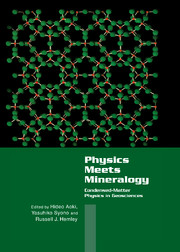Book contents
- Frontmatter
- Contents
- Preface
- List of Contributors
- Part I Introduction
- Part II Advances in Theoretical and Experimental Techniques
- Part III New Findings in Oxides and Silicates
- Part IV Transformations in Silica
- Part V Novel Structures and Materials
- Part VI Melts and Crystal–Melt Interactions
- Subject Index
- Materials Formula Index
- Index of Contributors
Preface
Published online by Cambridge University Press: 05 November 2011
- Frontmatter
- Contents
- Preface
- List of Contributors
- Part I Introduction
- Part II Advances in Theoretical and Experimental Techniques
- Part III New Findings in Oxides and Silicates
- Part IV Transformations in Silica
- Part V Novel Structures and Materials
- Part VI Melts and Crystal–Melt Interactions
- Subject Index
- Materials Formula Index
- Index of Contributors
Summary
If you look at the cosmic abundance of elements, oxygen, carbon, neon, nitrogen, magnesium, and silicon are the top six (apart from hydrogen and helium); most of them are indeed the main constituents of rock-forming minerals. If the goal of modern mineralogy is to understand classes of materials on an atomic scale, this is also the aim of modern condensed-matter physics. Therefore it is natural that condensed-matter physics should be applied to mineralogy and earth sciences, just as particle physics is a key tool in understanding cosmology.
This book is intended to give a state-of-the-art description of intensive interactions between geophysics and condensed-matter physics that recent years have witnessed. Although you might assume that, given the maturity of the solid-state physics, the crystalline structures of materials must have been readily understood in atomistic, nonempirical terms, this rather naive expectation has not been satisfied until quite recently.
Although traditional mineralogical principles had remained largely empirical, a few individuals pursued the idea that modern theoretical solid-state physics must become the foundation of mineralogy and geophysical sciences. One of the pioneers in this respect is Professor Yoshito Matsui in Japan. Following the tradition of Goldschmidt, he realized the importance of identifying and characterizing the underlying physics that controls geochemical, geophysical, and geological phenomena over the entire range of pressure and temperature relevant to the Earth. In so doing, he, in collaboration with Dr. Eiji Ito, directed the development of new experimental high-pressure facilities that would be required for understanding the rich and sometimes unexpected behaviour of minerals under conditions found deep within the Earth.
- Type
- Chapter
- Information
- Physics Meets MineralogyCondensed Matter Physics in the Geosciences, pp. xiii - xivPublisher: Cambridge University PressPrint publication year: 2000



